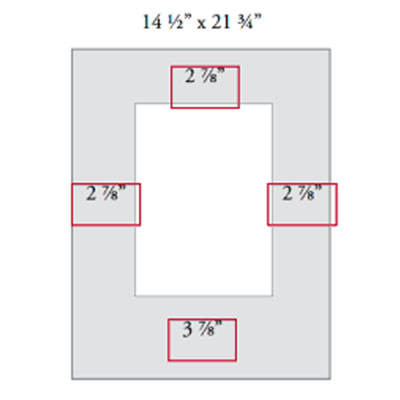To choose mat colors, consider the three most often used criteria:
A. The art—mat colors based on the characteristics of the artwork: its colors, textures and subject matter.
B. The background—how the artwork will coordinate with its intended surroundings.
C. Personal preferences—such as favorite colors.
THE ART
Ideally, the artwork and the framing that displays it should be compatible in style and color.
To choose mat colors that enhance the art, look at the art piece carefully and note the colors that are most and least prominent: which color covers the most area and which the least? Use mat colors in similar proportions. For example, if choosing mats for a watercolor featuring a red barn, the most prominent color may be the unpainted portion of the white watercolor paper, and the second most prominent color might be the red of the barn. A double mat that uses a white top mat and a red liner mat would be appropriate. If matting a photograph of a blue lake with trees and sky, blue would be the most prominent color, with perhaps the green of the trees or the white of the clouds as accent colors.
Another method for choosing mats that feature the art is the "artist's intent" approach. No matter what is being framed—a photograph, a limited edition print, a poster, a child's drawing, a set of baseball cards, a certificate, a needlepoint or a collection of coins—when the item was created, the artist, photographer or designer made many choices that determined the style and "feel" of the item.
Consider the size, the texture, and the lines of the piece. Are there bold brush strokes? Are the colors dark, pale, bright? Is the piece strong? Delicate? Consider the subject matter: is it serious, whimsical, contemporary? Try to echo the character and "feel" of the piece in the framing design.
THE BACKGROUND
For some people, the primary goal of the framing design is to coordinate with the room where the art will be displayed. To choose mat colors using this idea, ask the following questions: Is the wall light, medium, or dark? Is it painted, patterned, textured? What is the style of the decor in the room where the art will hang? Clean and contemporary? Warm and earthy? Is everything blue?
These characteristics of the environment can influence the color of the matting, but compatibility with the art should still play some role in the choice.
Should the framing design match the wall color? This can be very difficult due to the different textures of matboards and walls. Better to choose a lighter or darker version of the wall color than to try for an exact match.
PERSONAL PREFERENCE
Some people like to use white or cream mats on almost everything they frame, believing that this allows art of any color and style to stand on its own, with no interference from the mat colors. Museums typically use this style of matting in their displays.
Some people like to use matting to brighten a room with a splash of vibrant colors; others like to put their favorite color on everything they frame for their home. Choosing mat colors according to personal preferences is a valid option. And compromises can be made—such as using a favorite color as a liner mat, with an art-friendly color as the top mat. It may not show the artwork to its best advantage, but the owner of a piece of art may display it in whatever color scheme is pleasing to their own, individual eye.












